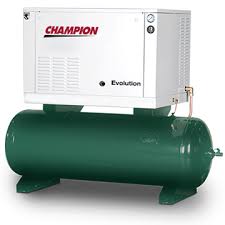
When you’ve grown up around air compressors – literally in my case, it means that the jargon is second nature. However I know I often forget this when speaking to clients and often there is confusion when a couple of different terms get blurred.
So I thought I’d take the time to remind you of those easy to confuse definitions.
Capacity is the quantity of air the compressor can pump out. Capacity is rated at based on the conditions of pressure, temperature and moisture content existing at the compressor inlet flange.
Mass flow (lb/min or kg/hr) Compressor performance is specified by a curve of delivery pressure against a mass flow rate for a constant velocity:
CFM (Cubic Feet per Minute) (M3/min) is a volumetric measurement not dependent on inlet conditions such as temperature, pressure and humidity.
ACFM (Actual Cubic Feet per Minute) (M3/min) represents ‘useful air’ and is independent of the seal losses through the machine. The commonly used value for seal losses with carbon seals is about 1%. Some centrifugal compressors may have other air losses between the inlet and discharge flanges.
ICFM (Inlet Cubic Feet per Minute) (or M3/hr) is a measure of the air entering the compressor. ICFM is the most common method of determining centrifugal compressor selection.
FAD (Free Air Delivered) indicates delivered air at inlet conditions. FAD is read before the inlet filter and inlet piping thus not taking into account this pressure drop which is normally anywhere from .2 to .5 PSIA with a relatively clean filter. This can be misleading because performance is calculated on an inlet pressure that is higher than the actual air volume entering the unit resulting in lower output than expected.
ICFM, ACFM and FAD are used interchangeably to reference delivered air. When using published data to run operating performance comparisons it is important to use ICFM or ACFM or FAD consistently. Be clear if inlet pressure is being acquired or estimated.
What is SCFM? SCFM (Standard Cubic Feet per Minute) (Nm3/hr) is the CFM at normal inlet conditions of 14.5 PSIA(1 bar), 68° F (20°C), and 0% relative humidity. SCFM can be based on inlet or discharge and it should be specified one way or the other. The most common use is inlet flange measurement.
Operating comparisons should only be evaluated at the same inlet temperature, pressure, relative humidity and cooling water conditions, as well as the same discharge pressure.
A good supplier will want you to specify worst case conditions, i.e. warmest conditions to insure the compressor is capable of meeting the desired output. If you don’t you’ll get the standard design conditions of:
Compressor Pressure Definitions
PSI is a pressure rating which means pounds per square inch.
PSIG is gauge pressure which reads the psi above the ambient or barometric pressure:
PSIA is ambient barometric pressure that varies with the altitude and the weather. This is a very important value when evaluating or estimating any compressor performance; particularly, centrifugal compressors. PSIA is needed to convert ICFM or ACFM to SCFM (M3/hr to Nm3/hr).
Understanding Horsepower and power cost
Motor horsepower – references the nameplate horsepower.
(BHP) Brake Horsepower is the input power required at the compressor input shaft to drive compressor at rated flow and rated pressure.
Input Motor Power in kW – (can be measured or calculated) that generates kWh – the amount of power consumed which drives the power bill. Input motor power is affected by such factors as motor efficiency, power factor, motor conditions, starter and disconnect conditions, power quality and many more.
Specific Power
SCFM (Nm3/hr) is typically the flow rating (projected or measured) for an input kW. With this data, each unit’s specific power in SCFM or Nm3/hr/kW input is calculated. (Note that many manufacturers use BHP/100 cfm.)
BHP/100 cfm does not include the actual operating energy requirement (such as other losses in the couplings, main drive, and controls which increase the projected operating up to 20%).
I hope this guide has explained some of the subtle differences between different air compressor performance measures. If you need help assessing your needs for a new air SCFM air compressor or having trouble with the performance of an existing unit then give the team at Pye-Barker a call on 404-363-6000 or drop us a line sales@pyebarker.com and we will take care of you.


